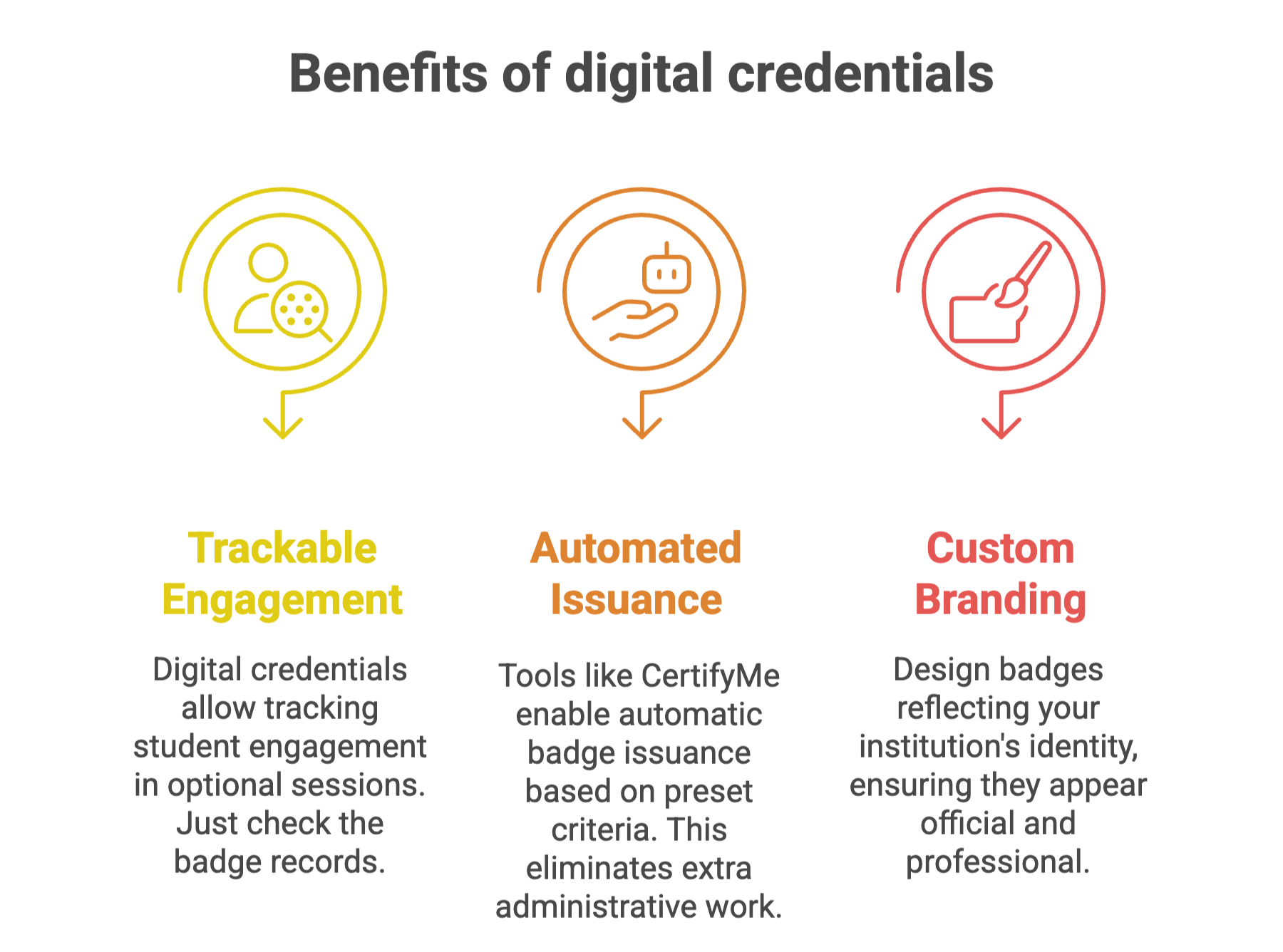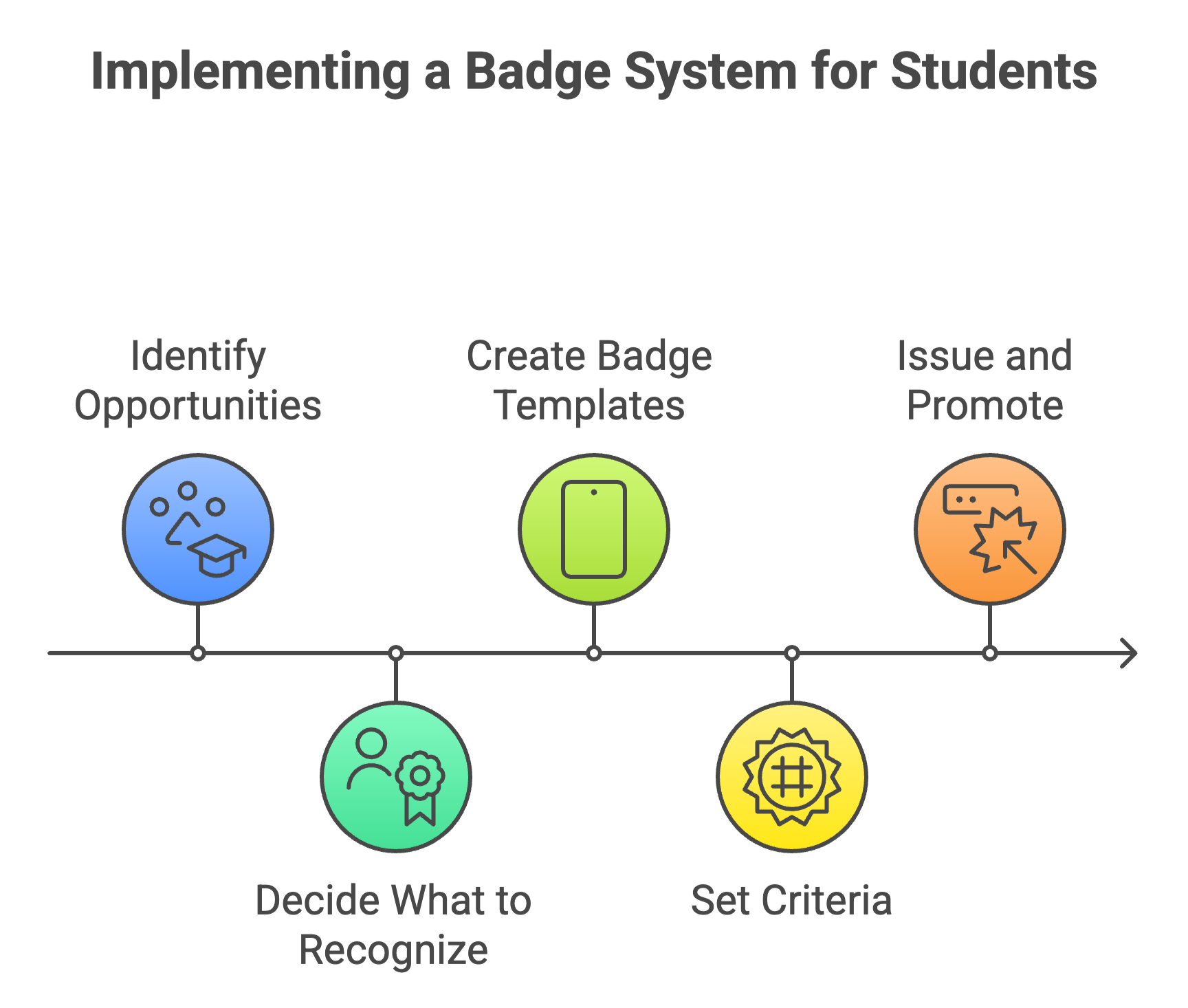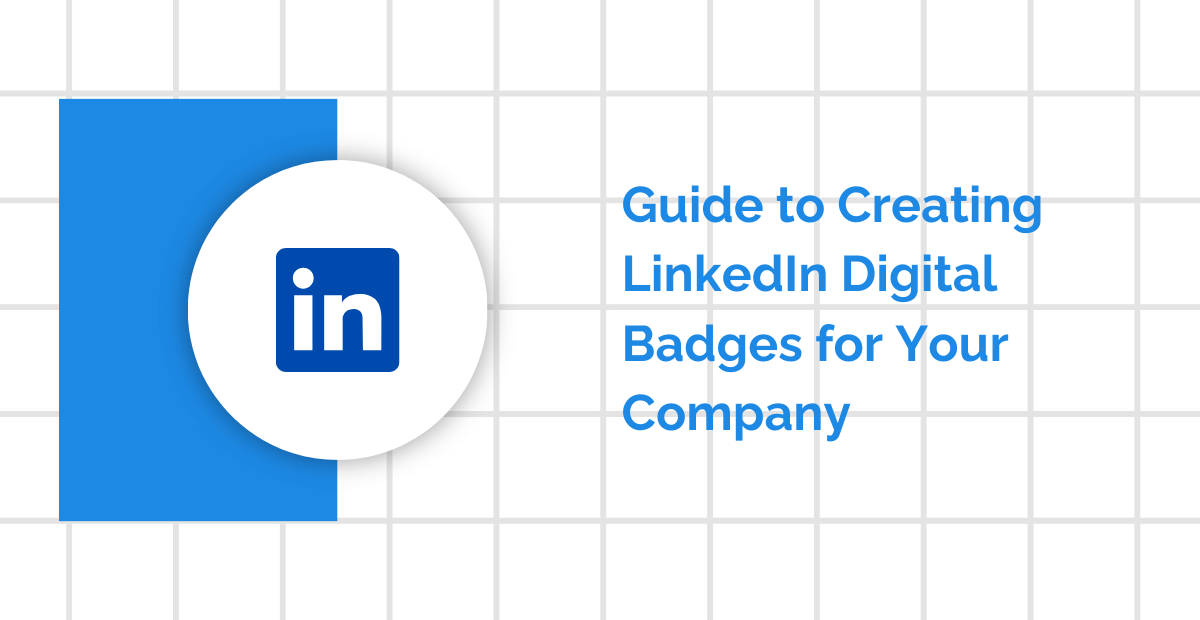Let’s be honest—online classes aren’t always the easiest thing to sit through. If you’ve ever taken a virtual lecture, you know what it’s like. Cameras off. Mics muted. Maybe a couple of students responded in the chat. The rest? Probably distracted, disengaged, or just waiting for it to end.
For university staff, this shift to online learning has brought its own set of challenges. How do you know if students are participating? How do you encourage interaction, especially when you can’t read the room?
Now, imagine if students could earn something—not just a grade—but visible, digital proof of their efforts. Enter: digital credentials. These aren’t some flashy gimmicks. Think of them as little pats on the back—recognition for doing something meaningful, even if it’s just attending a webinar or finishing a module.
In this blog, we’ll explore how digital credentials are changing the way students engage online. We’ll keep it simple, conversational, and real. Whether you’re a student trying to get noticed or a registrar wanting students to stay involved, this guide is for you.
Section 1: What Exactly Are Digital Credentials?
Digital credentials might sound fancy, but the concept is simple. They’re like the modern-day version of certificates and awards—only better suited for the online world.
Let’s break it down. There are mainly two types of digital credentials you’ll come across:
-
Digital Badges: These are small visual symbols given for a specific skill, task, or achievement. For instance, completing a peer review, finishing a leadership module, or learning how to use Excel.
-
Digital Certificates: These are more formal recognitions, usually for completing an entire course or attending a verified event.

Imagine this: You attend a virtual resume-writing workshop. At the end, instead of just a “thank you for attending,” you receive a digital badge that says “Resume Builder Pro.” You can then add this badge to your LinkedIn, portfolio, or email signature. Simple, right?
Digital credentials are not just stickers or icons. They often come with metadata—details about what you did to earn them, when you did it, and who issued it. Platforms like CertifyMe make this process smooth by allowing institutions to create, design, and issue these credentials easily. Explore how digital credential management platforms work and their role in online learning.”
It’s kind of like getting verified on social media, but for your learning. They show that you’ve done something real—and that someone credible says so. And because they live online, they’re easy to store, share, and even stack together into a skills profile.
So the next time someone says digital credentials are just digital gold stars, you can tell them they’re actually powerful, portable, and professional.
They’re like the modern-day version of certificates and awards—only better suited for the online world. Learn more about what digital credentials actually are and why they matter.
Section 2: Why Students Actually Care About These Things
Now, you might be wondering—do students really care about digital credentials?
Let’s look at it from a student’s perspective. In a physical classroom, you get nods, comments, even a pat on the back. Online? Not so much. Many students feel like they’re learning in a vacuum. No feedback. No sense of growth. Just assignments and deadlines.
This is where digital credentials come in. They offer micro-recognition.
-
Every badge says, “Hey, you did something worthwhile.”
-
Every certificate says, “Here’s proof you made progress.”
And this matters—especially to today’s students who are actively building their personal brand. Whether it’s for internships, grad school, or side gigs, students want to show more than just a transcript.
For example, Maria, a sophomore studying marketing, attended three online workshops on data analytics. Each time, she got a digital badge. When she applied for a summer internship, she attached her CertifyMe badge links to her resume. One recruiter mentioned it during her interview. That recognition? It gave her confidence—and an edge.
Digital credentials help students feel seen. They break the monotony of online learning by adding small wins. And they’re not just for high achievers. Even students who struggle in traditional grading systems can earn badges for showing up, improving, or helping a peer.
Plus, they’re sharable. You can post them on your LinkedIn profile, add them to your digital portfolio, or include them in your email footer. They’re not just proof—they’re promotions.
In a world where every extra line on a resume counts, digital credentials are a low-effort, high-reward way for students to stand out. So yes, students care. A lot more than you might think.
Whether it’s for internships, grad school, or side gigs, students want to show more than just a transcript. Digital credentials are becoming equally essential in professional and commercial spaces.
Section 3: What Engagement Actually Looks Like—With Digital Credentials in Play
Let’s visualize a better online learning experience. One where students aren’t just logging in—they’re leaning in.
Picture this: A student dashboard with clear weekly goals. Each completed task unlocks a badge. Not just any badge, but one they can use. Attend three webinars? Get the “Curious Learner” badge. Help a peer? Earn a “Community Mentor” certificate.
Suddenly, learning feels different. It’s no longer just about passing or failing. It’s about collecting moments, building a profile, and getting recognized in real time.
What drives engagement in this model?
-
Gamification: Students love to compete—even if it’s with themselves. Earning badges can be a fun, motivating way to track progress.
-
Clear Feedback: Instead of vague “good job” comments, badges offer a tangible sign that something was achieved.
-
Visual Progress: Stacking credentials on a profile shows growth at a glance.
And let’s not forget—credentials offer a sense of control. Students can choose what to focus on, what to earn, and how to showcase it. This choice increases buy-in.
Platforms like CertifyMe make it easy for universities to integrate these badges into existing LMS platforms. And when institutions issue official badges, students feel they’re earning something credible—not just another participation trophy.
Real-world example? At a university in Arizona, students enrolled in a sustainability course earned badges for completing modules early, participating in group forums, and leading community projects. Not only did this increase class participation, but it also boosted peer-to-peer interaction. Students said the badges made them feel accountable—and proud.
Engagement doesn’t mean loud discussions or hours on Zoom. Sometimes, it’s as quiet as a student unlocking a badge and thinking, “I’m doing okay.”

Section 4: What This Means for University Staff (Like You)
From the staff perspective, digital credentials may sound like more work. But in reality, they can actually make your job easier.
First off, they help make invisible work visible. Students often do things outside the curriculum—volunteering, mentoring, skill-building. Badging these efforts gives staff a way to track, record, and celebrate those contributions.
Here’s what digital credentials offer to staff:
-
Trackable Engagement: Want to know how many students completed optional sessions? Just check the badge records.
-
Automated Issuance: Tools like CertifyMe allow for auto-issuing badges based on pre-set criteria. No extra admin work.
-
Custom Branding: You can design badges that reflect your institution’s identity—making them official and professional.

Think of it like creating a digital co-curricular transcript. One that shows the full picture of a student—not just grades but growth.
And yes, there’s a broader benefit. Students who feel recognized are more likely to stay enrolled, participate, and succeed. In other words, digital credentials can indirectly support student retention and success metrics.
They’re also great for reporting. Want to showcase how many students took up leadership opportunities or learned outside the classroom? Pull up the badge analytics. Present it to accreditation bodies or use it in your next grant proposal.
And when institutions issue official badges, students feel they’re earning something credible—not just another participation trophy. Ensuring this credibility also means preventing fake credentials, which digital systems can help with.
In the long run, digital credentials can shift how learning is measured and valued. And that’s good news—for everyone involved.
Section 5: Small Steps to Start Using Digital Credentials
You don’t have to reinvent your entire system to get started. In fact, most institutions begin with just one or two use cases.
Here’s a simple roadmap:
-
Identify Opportunities: Look for events, workshops, or activities students already participate in.
-
Decide What to Recognize: Participation? Leadership? Collaboration? Pick what matters.
-
Create Badge Templates: Work with a platform like CertifyMe to design badges that are clear, branded, and meaningful.
-
Set Criteria: Decide what actions trigger a badge. Finishing a task? Attending three sessions?
-
Issue and Promote: Start issuing badges and encourage students to share them.

You don’t need a tech overhaul. Just start with what you already do—and layer recognition on top.
Institutions across sectors, including governments, are recognizing the power of digital credentials. Read how digital credentials are being applied in the public sector.
Example: The registrar’s office could issue a “Transcript Pro” badge for students who complete a self-guided tutorial on how to request academic records. Simple, helpful, and it encourages responsible student behavior.
Start small. Celebrate often. And let your students become your best advocates.
Conclusion: Why This Isn’t Just a Trend—It’s a Tool
Let’s bring it all together.
Online learning isn’t going away. But it doesn’t have to feel distant or dull. With digital credentials, we have a way to make learning feel human again.
For students, these badges and certificates offer more than just pixels—they offer proof, pride, and purpose. For staff, they offer a smarter way to track engagement, showcase outcomes, and support student success.
At CertifyMe, we’ve seen how even a single badge can spark motivation. It’s not about flashy technology. It’s about meaningful recognition.
So whether you’re managing student programs or attending them, think of digital credentials as small sparks. One by one, they can light up the entire learning experience.
Ready to start? We’re here to help.

 Author :
Author : 




